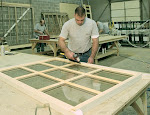
A customer of mine commented the other day that putty glazing windows is a lost art and I would have to agree with him. As is the case with any art form, there are many hidden challenges in the proper usage of glazing compounds. I am going to address the problems to avoid when finishing glazing putty.
Glazing putty is a mix of boiled linseed oil, calcite lime, inorganic fillers and other common elements. The most popular brand is DAP 33, but there are other manufacturers such as Sarco that produce the similar material. It takes a great deal of practice and patience to become proficient at forming the putty in a straight line and tooling crisp corners. You can find several articles and YouTube videos that might help in accelerating your learning curve. A link to the DAP product data might also be helpful: http://www.dap.com/docs/tech/00010401.pdf
Most people have no concept of how long it takes for glazing compound to cure. Inexperienced users are astounded to discover that it can take up to three weeks to cure depending upon temperature, humidity, and thickness of the application. We have been able to reduce the curing time by introducing heat and fans in a specially designed curing oven. The biggest mistake we have seen in the use of putty is when it is finished prior to proper curing. When this occurs, the paint finish will lose its adhesion and display bubbles, cracks, and wrinkles. It is essential to wait until the glazing has skinned over and attained a firm set prior to applying any finish.
Another problem can occur if the wrong combination of finishes is applied to the glazing compound. Many people want to avoid the priming stage of finishing, which can be catastrophic. A good oil-based primer should be used prior to applying two coats of latex finish paint. Since the putty is linseed oil based and since the compound is flexible and continues to move as it fully cures, the superior adhesion qualities of an oil-based primer is essential. Failure to properly prime the putty can cause your finishes to delaminate.
One should also be careful in using certain finishes over glazing compounds. This especially occurs when putty is used to glaze steel windows. Most finishes designed for metals are not designed with the same elasticity and flexibility of traditional latex-based paints commonly used in wood finishes. The manufacturers of fluoropolymer paints and other steel finishes state that their finishes are not flexible enough to be applied over glazing putty. This type of finish is considered a rigid system and it will crack and eventually delaminate with any movement or thermal expansion or contraction of the glazing material.






No comments:
Post a Comment